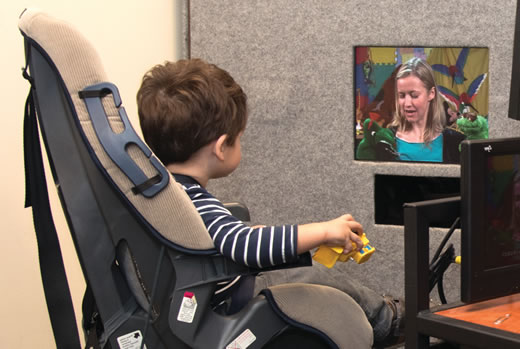fraternal twins
How Kids See the World Depends a Lot on Genetics
Posted on by Dr. Francis Collins

Caption: Child watches video while researchers track his eye movements.
Credit: Washington University School of Medicine, St. Louis
From the time we are born, most of us humans closely watch the world around us, paying special attention to people’s faces and expressions. Now, for the first time, an NIH-funded team has shown that the ways in which children look at faces and many other things are strongly influenced by the genes they’ve inherited from their parents.
The findings come from experiments that tracked the eye movements of toddlers watching videos of other kids or adult caregivers. The experiments showed that identical twins—who share the same genes and the same home environment—spend almost precisely the same proportion of time looking at faces, even when watching different videos. And when identical twins watched the same video, they tended to look at the same thing at almost exactly the same time! In contrast, fraternal twins—who shared the same home environment, but, on average, shared just half of their genes—had patterns of eye movement that were far less similar.
Interestingly, the researchers also found that the visual behaviors most affected in children with autism spectrum disorder (ASD)—attention to another person’s eyes and mouth—were those that also appeared to be the most heavily influenced by genetics. The discovery makes an important connection between two well-known features of ASD: a strong hereditary component and poor eye contact with other people.
Share this:
- Click to share on LinkedIn (Opens in new window)
- Click to share on Pinterest (Opens in new window)
- Click to share on Tumblr (Opens in new window)
- Click to share on Reddit (Opens in new window)
- Click to share on Telegram (Opens in new window)
- Click to share on WhatsApp (Opens in new window)
- Click to print (Opens in new window)
Posted In: Health, Science, Video
Tags: ASD, autism, Autism Spectrum Disorder, child behavior, child health, children, diagnosis, eye movement patterns, eye movements, fraternal twins, genetics, hereditary, identical twins, infants, social behavior, toddlers, twin study
